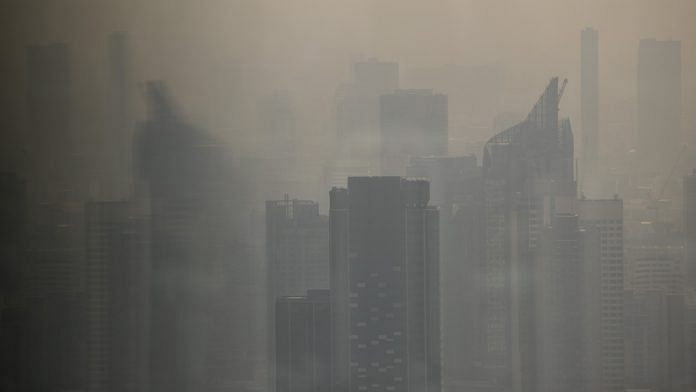Asteroid impacts used to be science popularizers’ favorite existential threat, but space rocks have been displaced by atmospheric carbon. This is not just fashion but the result of a new reading of our planet’s past.
In the 1990s, scientists thought asteroid impacts had triggered five mass extinctions, including the extinction of the dinosaurs 65 million years ago. Now, they’ve come to realize that the other four of the Earth’s mega-disasters probably came from within – triggered by belches of carbon into the atmosphere and oceans.
The worst of the five was an event called the end-Permian. It started with volcanic eruptions, which ignited carbon-rich sediments, infusing the atmosphere with a jolt of new carbon dioxide. Within a few thousand years, more than 90 percent of species went extinct.
Some people present this as a cautionary tale. Is that reasonable? It happened 252 million years ago, and the temperature rose more than the worst-case projections for fossil-fuel-induced global warming. On the other hand, it was a pretty good proof of principle.
The principle isn’t just that increasing carbon dioxide makes things get hot, but that fast changes in ocean and atmospheric chemistry can trigger a reordering of the living world. That in turn causes more chemical changes, leading to cascading changes in the biosphere. In the end-Permian, there was a collapse of plankton and fish and an explosion of bacteria that emit sulfur compounds and possibly others that exhale heat-trapping methane.
Seth Burgess, a United States Geological Survey geologist who studies the end-Permian, said there are two intriguing puzzles – the trigger mechanism and the kill mechanism. There’s a general agreement that the trigger was, in part, volcanic activity giving rise to an igneous formation called the Siberian Traps. But the eruptions alone couldn’t have released enough greenhouse gases to cause the estimated 10-15 degree Celsius rise in global temperature.
He’s proposed that the magma cooked vast carbon-rich sediments, releasing much more carbon into the atmosphere. As for the kill mechanism, the heat alone isn’t enough, so people have proposed various ways chemistry and biology went haywire. A new paper, published in Science this month, points to plummeting oxygen levels in the oceans. The conclusion comes from a study of which organisms died off and where.
Also read: Delhi’s air pollution is probably making you sad
The paper adds weight to an idea put forward a few years ago by Lee Kump of Penn State, a researcher I interviewed for a column back in 2011. Kump said that oxygen starvation killed some organisms, and left open niches for others to flourish. During the end-Permian, chemical traces suggest, green sulfur bacteria proliferated, gassing other living things with toxic hydrogen sulfide.
In his book “Under a Green Sky,” paleontologist Peter Ward used Kump’s idea to describe the world as it would have been just after the end-Permian: “Most of the shoreline is encrusted with rotting organic matter. Silk-like swaths of bacterial slick now putrefying under the blazing sun … from shore to the horizon there is a vast, flat, oily purple. … No fish break its surface. No birds. … We are under a pale green sky and it has the smell of death and poison.”
It sounds weird and cool, as long as this stays safely in the past, or we’re talking about someone else’s planet. But here we are on a warming Earth. Could the green sky and smell of death possibly be in our future as well?
MIT geophysics professor Daniel Rothman said he was initially skeptical. He’d read “The Sixth Extinction” by Elizabeth Kolbert, and wondered how she knew that climate change would cause another mass extinction. The Earth’s atmospheric carbon has gone up and down over geologic history, and only four times has mass extinction followed.
Rothman looked at 31 periods when atmospheric carbon rose, most of which didn’t have a big effect on the biosphere. When changes were big but happened slowly, life had a chance to adjust. If they happened fast but amounted to only a small carbon increase, life could go on as before.
Last year, Rothman came up with a formula based on both the rate and total amount of added carbon, and demonstrated that it predicted which of those 31 periods would lead to catastrophe. According to his formula, our current rate of emissions is extremely high, but it won’t cause a mass extinction unless our total emissions add 310 gigatons of carbon to the oceans. He published the results in Science Advances.
The UN’s Intergovernmental Panel on Climate Change estimates that human activity will add 300 and 500 gigatons of carbon to the oceans by the end of the 21st century, so 310 is close to the best-case scenario. When I talked to Rothman, he said to keep in mind the uncertainty. “By looking at the geochemical record, it would appear we are going to put the system on a track toward some type of instability,” he said. “But how that works is highly speculative.”
People talk about climate change being settled science, he said, but that refers to the most basic parts. Scientists know approximately how much our emissions are likely to warm the planet – a factor called the climate sensitivity.
What we don’t know, he said, is how this linear relationship might break down. “The big unknown unknowns are the positive feedbacks,” he said. “The big risk is the system takes off on its own.”
Of course, nothing is certain. There’s still a remote chance that an asteroid will trigger the next mass extinction before we do it.
Also read: Green movement set for clash with populists over pollution cuts




Thank you for posting wonderful post regarding Global Warning Emmission.